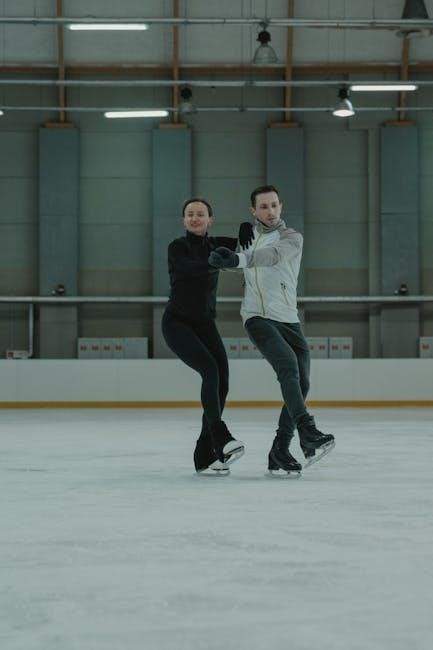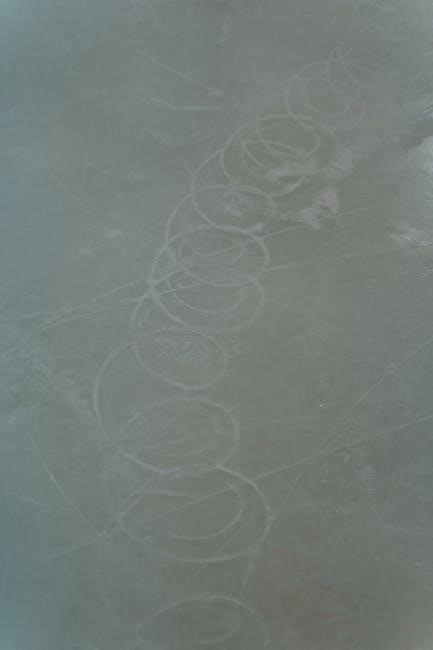Scapular dyskinesis involves abnormal scapular movement, affecting shoulder function and causing pain. Targeted exercises improve stability, posture, and reduce discomfort. Consistency is key for recovery and restoring proper movement patterns.
Understanding Scapular Dyskinesis
Scapular dyskinesis refers to abnormal movement patterns of the scapula during shoulder motions, often causing pain and dysfunction. It involves altered positioning or timing of the scapula, such as winging or excessive elevation. This condition can result from muscle imbalances, poor posture, or trauma, disrupting the normal scapulohumeral rhythm. Proper diagnosis and targeted exercises are essential to restore coordination and strength, addressing underlying issues like weak traps or poor movement patterns. Addressing scapular dyskinesis improves shoulder stability and overall joint function, reducing the risk of further injury or degeneration.
The Importance of Scapular Stability
Scapular stability is crucial for proper shoulder function and movement. It ensures the scapula maintains its position, allowing the arm to move efficiently. Stable scapular mechanics prevent excessive stress on the shoulder joint, reducing the risk of injury or degeneration. Weakness or poor control of stabilizing muscles, such as the trapezius and serratus anterior, can lead to dysfunction. Enhancing scapular stability improves overall upper body strength, posture, and athletic performance, making it a cornerstone of rehabilitation and injury prevention programs.

Types of Scapular Dyskinesis
Scapular dyskinesis is classified into three primary types: Type 1 (inflamed scapula), Type 2 (winged scapula), and Type 3 (irregular scapular movement). Each type requires tailored exercises.
- Type 1: Involves inflammation and limited mobility.
- Type 2: Characterized by a winged scapula appearance.
- Type 3: Marked by irregular or uncontrolled scapular movement.
Scapular Dyskinesis Type 1
Scapular Dyskinesis Type 1 is characterized by inflammation of the scapula, often due to overuse or repetitive strain. This type is marked by limited mobility and pain during shoulder movements. Exercises focus on reducing inflammation and improving scapular stability. Gentle stretches and low-intensity movements, such as scapular wall slides, are commonly recommended. Strengthening the surrounding muscles without aggravating the condition is key. A tailored rehabilitation program is essential to restore normal scapular function and prevent further complications.
- Gentle exercises to improve mobility.
- Focus on reducing inflammation and pain.
- Strengthening without overloading the scapula.
Scapular Dyskinesis Type 2
Scapular Dyskinesis Type 2 involves altered scapular movement patterns due to muscle imbalances. It is often characterized by excessive scapular elevation or depression during arm movements. This type frequently results from weakness in the serratus anterior or trapezius muscles. Exercises focus on restoring proper muscle activation and scapular symmetry. Scapular push-ups and wall slides are effective for improving movement patterns and reducing discomfort; Addressing these imbalances is crucial to prevent shoulder injuries and enhance overall upper body function.
- Altered movement patterns due to muscle imbalances.
- Exercises target proper muscle activation.
- Focus on improving scapular symmetry.
Scapular Dyskinesis Type 3
Scapular Dyskinesis Type 3 is characterized by a winged scapula, where the medial border protrudes due to weakness in the serratus anterior muscle. This type often results from nerve damage or prolonged muscle inhibition. Exercises focus on strengthening the serratus anterior and improving scapular control. Scapular wall slides and clock exercises are commonly recommended to restore proper movement patterns. Consistency in these exercises is key to reducing the winged appearance and enhancing shoulder stability.
- Characterized by a winged scapula appearance.
- Exercises target serratus anterior strength.
- Aims to restore proper scapular control.

Causes and Risk Factors of Scapular Dyskinesis
Scapular dyskinesis is often caused by muscle imbalances, poor posture, overuse, or trauma, disrupting normal scapular movement and shoulder function.
Muscle Imbalances and Weakness
Muscle imbalances and weakness in the scapular stabilizers, such as the trapezius, rhomboids, and serratus anterior, are primary contributors to scapular dyskinesis. When these muscles are weak or overactive, it disrupts proper scapular movement, leading to poor shoulder mechanics. Weakness in the serratus anterior, for example, can cause the scapula to wing or tilt abnormally. Similarly, overactivity in the trapezius can pull the scapula out of its normal position, creating dysfunction. Addressing these imbalances through targeted exercises is essential for restoring proper scapular function and preventing further injury or pain.
Poor Posture and Movement Patterns
Poor posture, such as forward head posture or rounded shoulders, can lead to scapular dyskinesis by altering the normal alignment and movement of the scapula. Prolonged sitting or repetitive movements without proper form can cause the scapula to tilt or wing abnormally, disrupting shoulder mechanics. Over time, these inefficient movement patterns strain the shoulder muscles, leading to pain and dysfunction. Correcting posture and movement patterns through exercises is crucial for restoring proper scapular function and preventing further injury or discomfort in daily activities and sports.
Overuse or Trauma to the Shoulder
Overuse or trauma to the shoulder can directly contribute to scapular dyskinesis by causing inflammation, muscle strains, or structural damage. Repetitive movements, such as throwing or heavy lifting, can overstrain the scapular muscles and ligaments, leading to abnormal movement patterns. Traumatic injuries, like falls or direct blows, can disrupt scapular stability and proper mechanics. These factors often result in pain, limited mobility, and poor shoulder function, making targeted exercises essential for recovery and restoring normal scapular movement in individuals with such histories.
Best Exercises for Scapular Dyskinesis
Scapular push-ups, wall slides, and the scapular clock exercise are effective for improving scapular stability and movement patterns. These exercises strengthen the muscles around the shoulder blade, promoting proper alignment and reducing pain. Consistency and proper form are key to achieving long-term benefits and preventing further dysfunction.
Scapular Push-Ups
Scapular push-ups target the muscles around the shoulder blade, improving stability and strength. Perform by starting in a plank position with core engaged, lowering your body slightly, and focusing on scapular movement rather than arm action. This exercise enhances proprioception and strengthens the serratus anterior and trapezius muscles, crucial for proper scapular function. Start with wall push-ups for those with limited strength, progressing to floor push-ups as stability improves. Regular practice helps restore scapular mechanics, reducing pain and improving posture. Proper form is essential to avoid shoulder strain.
Scapular Wall Slides
Scapular wall slides are a foundational exercise for improving scapular mobility and strength. Stand with your back against a wall, arms extended overhead, and elbows at 90 degrees. Slowly slide your arms up and down, maintaining contact with the wall, while keeping your shoulders relaxed. This movement enhances scapular upward rotation and reduces stiffness. It is particularly beneficial for addressing limited mobility and pain. Perform 2-3 sets of 10-12 repetitions, focusing on smooth, controlled motions. Proper form ensures effectiveness and prevents strain on the shoulders or elbows.
Scapular Clock Exercise
The scapular clock exercise targets the scapular stabilizers, improving their function and promoting proper movement patterns. Stand in a doorway or against a wall for support. Slowly slide your arms up the wall, moving your hands like the hands of a clock from 9 to 3. Focus on scapular rotation without arching your lower back. This exercise enhances scapular proprioception and strength, reducing dyskinesis. Perform 3 sets of 8-10 repetitions per side, ensuring smooth, controlled movements. Proper form is essential to maximize benefits and prevent strain.

Progressing Scapular Dyskinesis Exercises
Progressing scapular dyskinesis exercises involves advancing through stages, ensuring proper form, and gradually increasing intensity. It requires patience, consistency, and professional guidance to achieve optimal results safely.
Starting Without Weights
Starting scapular dyskinesis exercises without weights is crucial for rebuilding proper movement patterns and strength. Bodyweight exercises, such as scapular push-ups and wall slides, help improve scapular stability and control. This phase focuses on activating the correct muscles without adding external load, reducing the risk of further injury. It also enhances proprioception, which is essential for restoring normal scapular function. A physical therapist can guide patients through these initial exercises, ensuring proper form and progression at the right pace. This foundational step is vital before introducing resistance or weights.
Adding Resistance Gradually
Gradually adding resistance to scapular dyskinesis exercises helps strengthen the muscles without overloading the shoulder. Start with light weights, resistance bands, or even water-based exercises. Progress slowly, allowing the muscles to adapt and build strength. Avoid sudden increases in resistance, as this can lead to strain or poor form. Focus on controlled movements and maintain proper scapular mechanics. A physical therapist can help determine the appropriate weights and progressions. This approach ensures safe and effective strengthening, avoiding plateaus and supporting long-term recovery.
Incorporating Dynamic Movements
Dynamic movements enhance scapular function by introducing motion to exercises, improving muscle activation and timing. Examples include arm circles, scapular rotations, and dynamic wall slides. These exercises mimic real-life movements, promoting better scapular mechanics. Start without weights, focusing on controlled movements. Gradually add resistance, such as light dumbbells or resistance bands, to challenge the muscles further. Dynamic exercises improve strength, coordination, and mobility, aiding in the restoration of normal scapular movement patterns. Proper technique is essential to avoid compensations and maximize benefits.

Core and Rotator Cuff Exercises
Strengthening the core and rotator cuff is essential for scapular stability. Planks and rotational exercises enhance core stability, while shoulder rotations and cuff stabilizations improve shoulder function. These exercises address muscle imbalances, reducing the risk of injury and improving overall shoulder mechanics. Incorporate them into your routine for better scapular health and performance.
Plank Variations for Core Stability
Plank variations are highly effective for improving core stability, which is crucial for addressing scapular dyskinesis. Start with a standard plank, engaging your abdominals and maintaining a straight line from head to heels. For added challenge, try side planks to target the obliques or incorporate plank shoulder taps to enhance shoulder blade stability. Bird dogs and Superman planks can also be included to strengthen the lower back and improve posture. These exercises help stabilize the scapula by promoting proper muscle activation and reducing imbalances. Aim to hold planks for 30-60 seconds, gradually increasing duration as strength improves.
Exercises for Rotator Cuff Strengthening
Strengthening the rotator cuff is essential for addressing scapular dyskinesis. Begin with exercises like shoulder external rotations using light weights or resistance bands to target the infraspinatus and teres minor muscles. Internal rotations can also be performed to strengthen the subscapularis. Additionally, lateral raises and scapular-assisted shoulder rotations help improve muscle activation and balance. Start with low resistance and gradually increase intensity. Performing 3 sets of 12-15 repetitions is ideal. These exercises enhance shoulder stability and reduce the risk of further injury or dyskinesis.

When to Start Scapular Dyskinesis Exercises
Begin exercises when pain subsides and shoulder mobility improves, typically after a thorough assessment by a physical therapist. They ensure it’s safe to start and tailor the program to your specific needs and type of dyskinesis. Proper timing prevents worsening the condition and ensures effectiveness.
Assessing Pain and Limitations
Evaluating pain levels and functional limitations is crucial before initiating exercises. A physical therapist assesses shoulder range of motion, strength, and movement patterns to identify specific deficits. Pain is measured using standardized tools, ensuring exercises avoid exacerbating symptoms. This step guides the creation of a personalized program, addressing individual needs and promoting safe progression. Proper assessment prevents overloading the scapula and ensures exercises are tailored to current capabilities, fostering optimal recovery and functional improvement. Early identification of limitations helps in setting realistic goals and tracking progress effectively.
Guidance from a Physical Therapist

Consulting a physical therapist is essential for effective scapular dyskinesis management. They provide personalized exercise programs tailored to specific needs and deficits. A therapist assesses movement patterns, strength, and flexibility to design a targeted plan. Supervision ensures proper form and technique, reducing injury risk. They also offer modifications or progressions based on progress. Manual therapy, like joint mobilizations, may be incorporated to enhance mobility. Regular follow-ups allow for program adjustments, ensuring continuous improvement and addressing any emerging challenges. Their expertise helps maximize recovery and functional outcomes safely and efficiently.

Creating a Workout Routine
A well-structured workout routine for scapular dyskinesis should focus on strengthening shoulder stabilizers, improving posture, and enhancing flexibility, ensuring balanced muscle development and proper movement patterns.
Frequency and Duration
For effective scapular dyskinesis management, exercises should be performed 3-4 times weekly, with each session lasting 20-30 minutes. Start with shorter durations and gradually increase as strength and endurance improve. Focus on controlled movements and proper form to avoid exacerbating the condition. Consistency is key, but allow rest days to prevent overtraining. Over time, the frequency and duration can be adjusted based on progress and comfort levels, ensuring a balanced and sustainable routine for long-term shoulder health and stability.
Warm-Up and Cool-Down Routines
A proper warm-up and cool-down are essential for scapular dyskinesis exercises. Begin with 5-10 minutes of light cardio, such as arm circles or gentle shoulder rolls, to increase blood flow and prepare the muscles. Dynamic stretching, like shoulder flexion and extension, can enhance mobility. After exercising, cool down with static stretches for the shoulders and scapular area, holding each stretch for 20-30 seconds. Incorporate deep breathing to promote relaxation and reduce muscle tension. This routine helps prevent injury, improves flexibility, and supports recovery, ensuring safe and effective workouts for scapular health.

Monitoring Progress
Regularly assess exercise consistency and shoulder function to monitor progress. Adjust routines based on improvements in strength, mobility, and pain reduction to optimize recovery and performance.
Tracking Exercise Consistency
Consistency is key to improving scapular function. Use a workout log to track daily exercises, sets, and repetitions. Set realistic goals and schedules to maintain adherence. Celebrate small milestones to stay motivated. Regularly review progress to ensure exercises are performed correctly and consistently. Inconsistent effort can delay recovery and weaken results. Sticking to a structured plan helps build habits and accelerates improvement in scapular stability and overall shoulder health. Tracking also helps identify gaps in routines, allowing for timely adjustments to stay on course.
Evaluating Shoulder Function and Pain
Evaluating shoulder function and pain is crucial to monitor progress and adjust exercises. Use validated scales like the Visual Analog Scale (VAS) to measure pain levels. Assess range of motion, strength, and scapular movement patterns. A physical therapist can perform specific tests, such as the Scapular Assistance Test, to evaluate dysfunction. Regularly documenting improvements in function and reductions in pain helps guide the exercise program. Observable gains in mobility and strength indicate effective rehabilitation. Pain reduction often correlates with improved scapular stability and overall shoulder health.

Frequently Asked Questions
Common questions include whether exercises alone can resolve scapular dyskinesis, the typical recovery timeline, and if physical therapy is necessary for optimal results.
Do I Need Surgery for Scapular Dyskinesis?
Surgery is rarely needed for scapular dyskinesis and is typically considered only in severe cases where conservative treatments fail. Most individuals benefit from targeted exercises, physical therapy, and addressing underlying muscle imbalances. Surgery may be necessary if there is significant structural damage, such as a shoulder injury or chronic pain unresponsive to rehabilitation. Always consult a healthcare professional or orthopedic specialist to determine the appropriate treatment plan for your specific condition.
How Long Does Recovery Typically Take?
Recovery from scapular dyskinesis varies depending on severity and adherence to treatment. Mild cases may improve in 4–6 weeks with consistent exercises, while more severe cases can take 3–6 months. Factors like underlying injuries, muscle imbalances, and rehabilitation consistency impact recovery time. A well-structured exercise plan and proper guidance from a physical therapist can accelerate progress. Patience and dedication are key, as full recovery requires time to restore scapular stability and strength. Regular follow-ups with a healthcare provider ensure optimal outcomes and prevent recurrence.